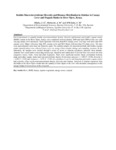Benthic Macro-invertebrate Diversity and Biomass Distribution in Relation to Canopy Cover and Organic Matter in River Njoro, Kenya

View/
Date
2013Author
Mbaka, John Gichimu
Mathooko, Jude M
M'Erimba, Charles Mwithali
Metadata
Show full item recordAbstract
Field experiments to quantify benthic macroinvertebrate density, diversity and biomass and benthic organic matter
(BOM) content in the River Njoro, Kenya, were conducted between January 2009 and April 2009 at four sites with
varying canopy cover intensities: Njoro upstream with more than 90% canopy cover, Tree-tops with more than 60%
canopy cover, Mugo with more than 50% canopy cover and Mill House with less than 1% plant cover. The sites
were approximately more than one kilometre apart. Ten random samples for macroinvertebrate and benthic organic
matter quantification were collected from every site using a Hess sampler during each sampling occasion. In the
laboratory, all samples were washed through a series of sieves to separate extraneous materials from animals.
Animals were sorted under a dissecting microscope, identified and enumerated. Collected litter was sorted into four
categories: leaves, fruits, wood and plant fragments. There were significant positive linear correlations between
plant particulate organic matter and macroinvertebrate density (Correlation analysis: r = 0.89, P < 0.05), diversity (r
= 0.80, P < 0.05) and biomass (r = 0.79, P < 0.05). In conclusion, it can be said that plant particulate organic matter
had a positive effect on the macroinvertebrate density, diversity and biomass. Removal of riparian vegetation from
the banks of the River Njoro would alter the quantity of litter inputs to the river with attendant consequences to the
energy budget of biocoenoses in the ecosystem
